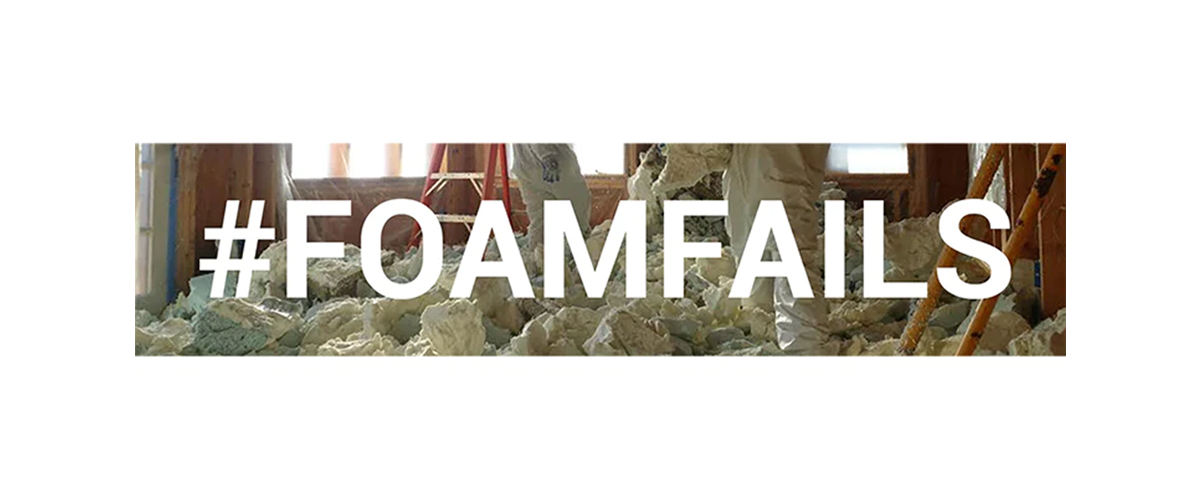
Poor installation quality control results in cracked, crumbling foam that has little insulation value. This foam was estimated to be less than 10 years-old at the time of retrofit.
It’s important that a building's air barrier and insulation be dimensionally stable - or resilient to movement. Foam is neither.
The curing process after spray foam is applied inherently entails shrinkage and hardening. Not only can such shrinkage result in pulling back from stud bays and other connections - which often leads to gaps in the insulation layer - it can lead to cracking within the foam structure itself. Because foam’s performance is hypersensitive to slight manufacturing variations, it is best controlled by factory application. But too often spray foam is applied on the job site under poorly controlled conditions - something we’ll talk more about in a later post.
Gregg Labbe, of BlueGreen Consulting Group, writing in GreenBuildingAdvisor says,
"The first rule with spray foam is 'hire the installer spraying the foam, not the foam manufacturer or the foam brand.' By this I mean, the installer’s brain is the most valuable asset in selecting who will do the job. All else is secondary."
Spray foam lifts shouldn’t be thicker than 2” each time and should be allowed to cool before another lift is applied - but sometimes, to achieve 6” thickness, operators apply two 3” lifts and in quick succession. This generates massive amounts of heat and increases the likelihood of cracks. Gregg has a great video investigating such a problem here:Spray foam is rigid and inflexible once it cures, and foam boards are rigid from the outset. So when these materials expand and contract because of temperature changes - and that’s when, not if - they can crack. In the case of boards, we've heard of those who have peeled back the exterior sheathing of their building to reveal that the tongue has completely separated from the groove in a foam board system, making the fiberglass insulation below visible.
These cracks are incredibly hard to repair. Interior walls must be entirely deconstructed to fill them in - probably with more foam, which is likely to crack yet again before long. It is nearly impossible to repair cracked, compromised foam insulation. Once it’s cracked or pulled away, its effectiveness as an insulation layer isn't just diminished - it's devastated. It ends up a long-term, toxic, wall-filler without insulative value, which is super difficult to remove.
 Spray foam in the ceiling of a new construction project in Connecticut.
Spray foam in the ceiling of a new construction project in Connecticut.
Even when foam is applied perfectly, it's better to choose insulating materials that are resilient to these shifts in temperature and humidity, and which are capable of stretching without compromising the integrity of the insulation layer and air barrier. Dense-packed cellulose, wood fiber, or fiberglass insulations don't entail the negative environmental and health impacts of foam - each are great alternatives. These insulations can be blown in behind a vapor-intelligent interior air barrier like the INTELLO Plus membrane which can be sealed with flexible tapes, ensuring an assembly that is resilient to movement, and capable of withstanding environmental fluctuations without the risk of compromised building performance.
Foam cracks. Continuous insulation is important to a high-performing building - so why take the risk of having a crack-laden insulation layer whose performance degrades over time? For being brittle, rigid, and crumbling, we see yet again that foam fails.
References:
- Foam Shrinks, and Other Lessons: Correction, Building Science Corporation, by Joe Lstiburek, May 2012 (pdf)
- When Spray Foam Cracks, BlueGreen Consulting Group, June 20, 2015
- When Spray Foam Goes Bad, GreenBuildingAdvisor, Greg Labbe, August 2, 2016
- Using Rigid Foam As a Water-Resistive Barrier, GreenBuildingAdvisor, by Martin Holladay, Sept 3, 2010
- Spray Foam Insulation Is Not a Magic Bullet, GreenBuildingAdvisor, by Carl Seville, March 8, 2013
- GUEST POST: Spray Foam, Infrared Cameras, & the New Big Holes, Energy Vangueard Blog, by Jamie Kaye, March 21, 2012
- Spray Foam Shrinkage Problems, Matt Brown, post on SprayFoam.com, September 21, 2011



